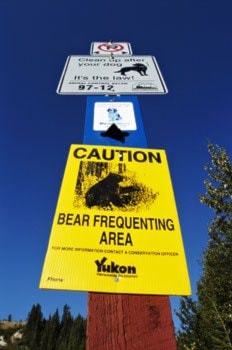Soapberries ripening along the clay cliffs are believed to be attracting grizzly and black bears deeper into Whitehorse city limits, according to Yukon conservation officers.
“These reddish-orange berries are what’s been attracting the bears to the area,” said conservation officer Tony Grabowski.
“They’re feeding on rich natural food sources. They’re doing what bears do.”
The latest sighting was on the cliffs off Main Street. Conservation officers did not find the bear.
Most sightings occur in the early morning or early evening, said Grabowski. Bears will be wandering around until mid- or late-October, when they go back into hibernation.
Bears have been seen this summer roaming the cliffs near the stairs at the end of Black Street and places between Cook and Hawkins streets, and near the Robert Service Campground.
A bear was also spotted loping across Range Road near the young offenders’ facility.
People could be coming across the same bear, accounting for the numerous sightings — which are about average compared to past years — or there could be two or three bears in the area, said Grabowski.
Some people have reported spotting grizzlies, but the bears are most likely black bears of varying colours, he added.
Conservation officers have posted yellow warning signs at the main access points of the cliffs.
“We shouldn’t become hysterical about the sightings, but be aware and take precautions,” said Grabowski.
Conservation officers have noticed a change in the behaviour of bears spotted around the city.
Residents are mainly seeing the bears in wooded areas, away from the residential areas, which are attractive for the easily accessible trash cans, said Grabowski.
“We have a bear population conducting their business like wild bears should,” he added.
The bears seem to lack any food conditioning, which could be a result of the electrical exclusion fence erected around the Whitehorse landfill.
No longer weaned on human food, bears are keeping to the forest for nutrition, hence their soapberry search.
Even though area bears are not rummaging through garbage, residents are asked to remain vigilant about regular removal of trash from their homes.
“People need to realize this is bear country,” said Grabowski. “We have about 10,000 black bears and another 6,000 grizzlies. When they’re out of their dens, people have to be aware of their presence and ask themselves, ‘How will I react to a bear encounter?”
Conservation officers are responding to bear sightings and have set up culvert traps along the cliffs but have yet to snag a bear.
A bear would have to be in a tree to be darted. If a bear isn’t static when shot, it could use the tranquilizer’s five-minute reaction time to run, leaving officers less time to move the bear to another location.
Officers have darted two bears this year, one in Riverdale and another in the Marwell area.
If you encounter either a grizzly or black bear, it is recommend you try and determine its intent before reacting.
If a bear appears to be acting defensively, Grabowski said to lie on your stomach, cover your head and spread your legs to prevent the animal from rolling you over and exposing your vitals.
“(But) if the bear is attacking, then you have to fight with might,” said Grabowski.
Hikers and joggers should be carrying some sort of bear deterrent with them, such as bear spray or noise makers.
“Get into the habit of taking something with you,” said Grabowski. “More often than not, a bear will take off in the opposite direction — but just in case.”
